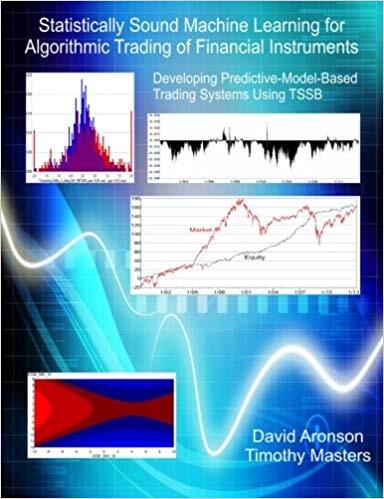Statistically Sound Machine Learning for Algorithmic Trading of Financial Instruments
Review Statistically Sound Machine Learning for Algorithmic Trading of Financial Instruments: Developing Predictive-Model-Based Trading Systems Using TSSB
by DAVID ARONSON, TIMOTHY MASTERS
Description
This book shows how an advanced and efficient statistical method can assess a trading system that is relevant to real-world applications. With step-by-step instruction and illustration with the use of legitimate market data, readers without advanced knowledge of the topic can still follow. More than that, the book shows how other techniques can be applied in the development and testing of trading systems, such as machine learning and statistical algorithms in TSSB. A well-managed application of these techniques can greatly contribute to a trading system that shows reliable data continuously after setting it up into a trading account.
This book is basically a manual to TSSB software, including an efficient step-by-step illustration of its application in trading systems. The book discusses the techniques well and presents a detailed discussion of the various mechanics and algorithms.
It provides reliable instruction into the real-world application of creating and testing a predictive model. However, the reader must have sufficient background about TSSB to keep up with the discussion. Also, it focuses too much on TSSB and fails to note the downsides of the software, which must also be highlighted to give the reader a well-rounded discussion of the matter. Overall, the book is still recommended for those interested to learn about TSSB, professional or amateur.
About the Authors
DAVID ARONSON has worked in the field of machine learning and nonlinear trading system development. He was an adjunct professor of finance and taught courses in data mining, predictive analytics, and technical analysis to financial engineering students.
TIMOTHY MASTERS holds a Ph.D. in mathematical statistics and specializes in numerical computing. He is the author of five books tackling classification, prediction, and practical applications of neural networks.
Table of Contents
INTRODUCTION
A SIMPLE STANDALONE TRADING SYSTEM
A SIMPLE FILTER SYSTEM
COMMON INITIAL COMMANDS
READING AND WRITING DATABASES
CREATING VARIABLES
SCREENING VARIABLES
COMMITTEES
ORACLES
TESTING METHODS
COMPLEX PREDICTION SYSTEMS
GRAPHICS
FINDING INDEPENDENT PREDICTORS
MARKET REGRESSION CLASSES
DEVELOPING A STAND-ALONE SYSTEM
